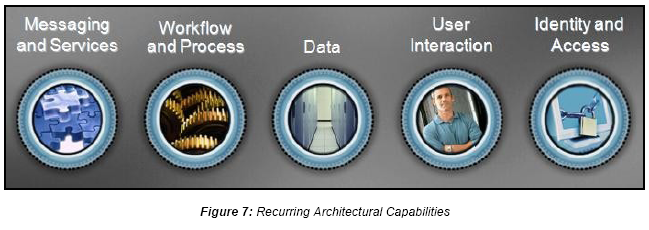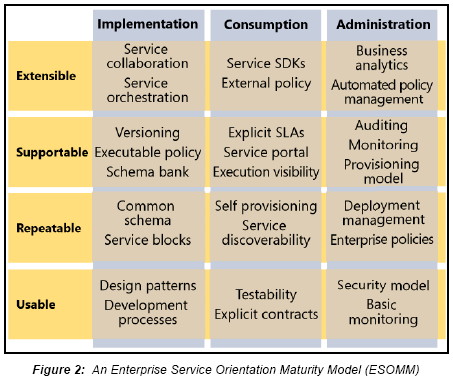微软《SOA in the Real World》笔记09——第二章
第二章:消息和服务
“SOA不是你所购买的,而是你所做的。”
——Jason Bloomberg
分析家
读者的收获
本章的读者将会建立起第一章中所介绍的概念基础,会重点关注消息和服务方面的架构功能。

消息和服务架构功能的重点是面向服务的概念,以及如何使用不同类型的服务来实现
SOA。本章也会涉及到用户的角色方面的问题——特别是指在SOA中用户是如何与服务交互的。本章中的主题包括:
-
SOA成熟度模型
-
服务生命周期
-
SOA样例场景
-
SOA中用户的角色
本章中所涉及的概念不一定是新的。很多厂商、顾问和行业分析家已经发表了
SOA成熟度模型和服务生命周期方面的出版物。像SOA本身,也没有一个大家一致同意的成熟度模型和服务生命周期。读者应该研究这些已有的成果,从中找出最适合自己组织需求的那些内容。
致谢
本章收录了如下一些人的工作成果:
Mark Baciak (服务生命周期), Atanu Bannerjee (OBA), Shy Cohen (服务分类), William Oellermann (企业SOA成熟度模型), 以及 Brenton Webster (SOA 案例研究)。
理解服务
SOA
成熟度模型
(
另一个
??)
厂商、顾问公司、分析家和作者们提出了大量的
SOA成熟度模型。这些模型的大部分都建立在SEI的CMM的基础之上。最近搜索术语“SOA成熟度模型”时,可以找到差不多10,000条相关链接(包括如何查找成熟度模型的文章)。既然对成熟度模型有这么高的兴趣,以及这么多可用的模型,为什么还要引入另一个呢?与其他成熟度模型不同的是,这里讨论的模型不是简单地把面向服务应用到CMM中去。ESOMM(面向服务的企业成熟度模型)借鉴了CMM的能力驱动成熟度模型理念,并把这些原则应用到面向服务中,基本上是从头建立起一个路线图。与CMMI不同的是,ESOMM成熟度模型的重点不在于流程,不关注组织是否准备就绪和采用方式,而是关注于IT能力。虽然与CMM的概念有些相似,ESOMM是成熟度模型的全然不同的应用方式。在ESOMM中定义的层、视点和能力已用来支持服务的路线图——指的不是具有特定使用方法的特定服务、特定实现方式,或者是特定应用,而指的是任何服务,更确切地说是一组服务本身。(
not any specific service with any specific use, implementation, or application, but any service, or more specifically, any set of services.)
开发企业级的
SOA策略不是无足轻重的事情,不能把它当成一个短期的或一次性的事务。SOA试图为整个组织建立起更高水平的敏捷性,以便更好地响应客户和业务的需求。SOA的许多方面,近期目标要比长期目标重要得多,所以组织的努力相应地与此保持一致也是至关重要的。为了能成功地做到这些,具有优先级的路线图需要高的优先级。ESOMM可以提供以能力为基础的、技术无关的模型,可以帮助识别出组织目前的成熟度水平,短期和长期的目标,以及改进的机会。
图
2是ESOMM的总括。ESOMM定义了4个水平成熟度层次,3个垂直方面以及27个用于支持SOA的必要功能。

大多数组织在模型中向上层移动时通常不会完整地实现一个层次中的所有功能,但是向前跳得太远是危险的。当认识到一些与关键构建块能力有关的不成熟的决定会严重地影响在更高层次的成熟度的时候,这一点就变得很明显了。
功能分为三个类别:实现、消费和管理。实现功能的重点是从提供者的角度来对待
Web服务的开发和部署。消费功能是把是把服务提供给消费者,使他们容易实现,因此获得更广泛、更成功地应用。管理功能包括那些便于在组织内操作和治理Web服务的功能。因为组织可以选择关于与单个方面,整个SOA的成熟度,或者是SOA的价值,就依赖于所有这三方面的适宜的关注水平。
ESOMM是一个工具,可用于:
-
简化非常复杂的分布式解决方案的复杂度。
-
探讨和识别组织对面向服务的采用。
-
理解服务应用的自然演化功能(例如在较低的层次中冒一定的风险跳过特定的功能)。
-
在客户目标的基础上为客户提供一个有内聚力的、全面的面向服务计划。
-
align an organization‘s activities and priorities with a distinct level of value providing specific benefits through specific capabilities 。
在
SOA评估中,每种能力单独进行评估,包括优势水平、足够水平,或者是短缺水平。优势水平。
In a SOA assessment, each capability is assessed independently as a level of strength, adequacy, or weakness. A level of strength demonstrates that the organization is well positioned to safely grow their use of Web services without fearing pitfalls in this area down the road. A level of adequacy signals that an organization has sufficient capabilities to meet today‘s needs, but is vulnerable to a growth in Web services that could cause problems in that area. A weakness represents a deficiency that is a problem for today‘s use of Web services and could be a serious detriment in the future. Any capabilities that are obviously not part of the organization‘s objectives and appear to have minimal impact in the near term for the organization are classified as not applicable. These areas may quickly become weaknesses if business or technical objectives were to change or accelerate.
As in the CMM, individual capability levels drive an overall layer grade ranging from 1 to 5. A grade is assessed based on the average of the capability maturities within the layer. A rating of 5 represents a mastery of that level with little or no room for improvement. A 4 represents a solid foundation within an area that can be successfully built upon. A 3 is assigned when good efforts are established in that layer, but extending efforts to the next layer carries some risks. 2 means that only initial efforts have been made in the area and much more work is needed to extend to the next layer. A grade of 1 represents no effort to address the capabilities at that layer.
既然已经简单地回顾了
ESOMM的组成部分,应该已经在考虑如何把它应用到组织中去。清楚的是,模型的应用不应该被看作一次性的或者是短期的过程。相反,应该把模型用于工作计划,可以随着服务的使用和经验的增长随时进行修改。
不幸的是,使用模型成熟度这个术语意味着人们想立刻知道他们的组织目前所处的状态或层次。这时,没有合适的方式来回答这样的问题,“我的组织在什么层次?”我们不采用在某个层次上的给出总的评级方法,而是采用了
we take the approach of giving each layer its own level of maturity, ranging from one to five, based on half-point increments
。
ESOMM的目的是成为一个路线图,而不是作为SOA “就绪”的标志或用于SOA评估。
ESOMM is intended to be leveraged as a road map, more so than as an SOA ―readiness‖ or assessment tool. While it is important to know where you are, getting an exact bearing is less important than identifying the capabilities you need to address to continue advancing the value of service enablement in your organization. As long as you are willing to ask yourself some hard questions in an objective manner across all the relevant groups, you should be able to get a good understanding for your current challenges. If you apply the strategy and objectives of your organization, you should be able to identify which capabilities you will need to address in the near, short, and long term.
ESOMM是众多用于企业评估SOA采用和实现能力的成熟度模型之一。… 与其它成熟度模型不同的是,ESOMM还可以当作帮助企业成功实现SOA的路线图。ESOMM和其他成熟度模型的目的是为组织成功实现SOA提供工具和信息,增强组织的能力。
ESOMM is one of many possible maturity models that can be used to assess the capabilities of the enterprise in adopting and implementing SOA. It is terribly difficult to have a concise, constructive conversation about a service-enabled enterprise without some common agreement on capabilities and maturity – ESOMM is one of many maturity models that attempt to address this issue. Unlike other maturity models, however, ESOMM can also be leveraged as a prioritized roadmap to help enterprises identify the capabilities necessary for a successful implementation. The goal of ESOMM and other maturity models is to empower your organization with the tools and information needed for a successful SOA implementation.
从某种程度来说,因为需要开发诸如注册和仓储等新的功能,
SOA使得基础设施更为复杂。
In a way, SOA does render the infrastructure more complex because new capabilities will need to be developed that did not exist before, such as registry and repository. In some sense, it can be compared to the construction of a highway network—broad, safe roads are more expensive to build, and the users need to upgrade their means of transportation to make the most of that infrastructure, but the cost per trip (in time and safety) is driven down. Until the network reaches a critical mass, drivers still need to be prepared to go ―off road‖ to reach their destination. Many enterprise applications were not developed with SOA in mind, and are either incapable of leveraging an SOA infrastructure, or will need to be upgraded to take advantage of it. However, with more/new applications being created consistently, there is a great opportunity to drive down new interoperability costs as the various technology vendors enable their products for SOA. The biggest challenge for SOA is convincing the application owners to invest more today to achieve those promised long term savings.
虽然像
ESOMM这样的成熟度模型能够帮助辨别SOA的必要能力,但通常不能回答组织中所需的服务类型这样的问题。简单的服务分类可以帮助更好地理解SOA中的服务的典型的范围。






















 1222
1222

 被折叠的 条评论
为什么被折叠?
被折叠的 条评论
为什么被折叠?








